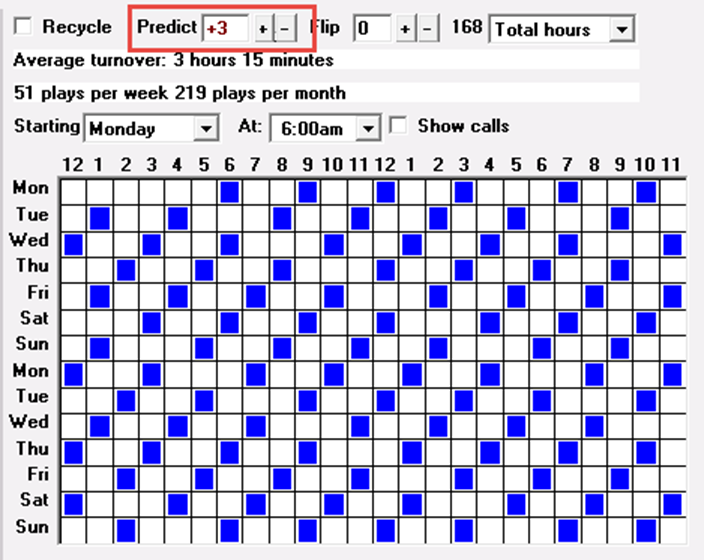We are, all of us, in the business of playing the same songs over and over. For some stations, it’s a few hundred, for other stations it’s a few thousand “same songs”. We begin with a well-curated list of songs selected to appeal to a specific demographic group of listeners. The quest is to schedule these songs in such away that the “same songs all the time” -effect is lessened as much as possible. This article for stations running the Hot Current Hits in very high rotation. The example below is showing 66 spins a week.
The first duty of music scheduling, as I view it, is to prevent the “same songs” from scheduling at the “same time” tomorrow. Here’s why: Everyone has their daily and weekly schedule. Teeth brushing, work or school commuting, lunch time, exercise time, laundry time, pet time. Radio is included the daily routines for almost all people in some measure and most of them listen at the same time every weekday and workday. Weekend listening patterns generally differ from weekdays. The lady who turns on her radio at 7am weekdays may not turn it on Saturday morning until noon. And maybe not at all on Sunday.
If we have captured their ears and the person is now a Loyal Listener, not everything we play will be a personal favorite, but they’ll stick with us because they have come to know that the overall music mix is to their liking. Now, if that Loyal Listener always has the Favorite Station playing during the daily 30 minute commute, and if “a song I don’t like” plays three times in that half hour during the week, the listener will switch to the Second Favorite Station. Or she might do it the second time it’s heard, especially if the “song I don’t like” plays during the commute two days in a row. This is a particular problem for Today’s Top Hits stations with short Current playlists formatted for high daily spins.
The song repeat-pattern for the tight rotation categories should look like this, stairsteps. No blocks on top of each other. Rotation patterns are always based on simple math involving two numbers; 1) Number of songs in the category and 2) Number of times the category is formatted in the week. The category below has ten songs. The category is formatted four times an hour. This means each song plays again two and a half hours later.
Use the Predict button to plan your rotation changes. Many times, adding or removing just a song or three can have result in an unwanted rotation pattern. The chart below shows what would happen to the above category’s song-repeat pattern and the lower weekly spins if we added three more songs to it.

